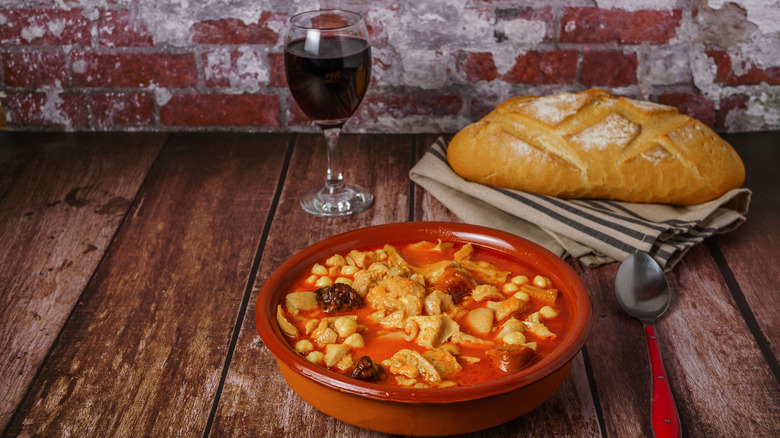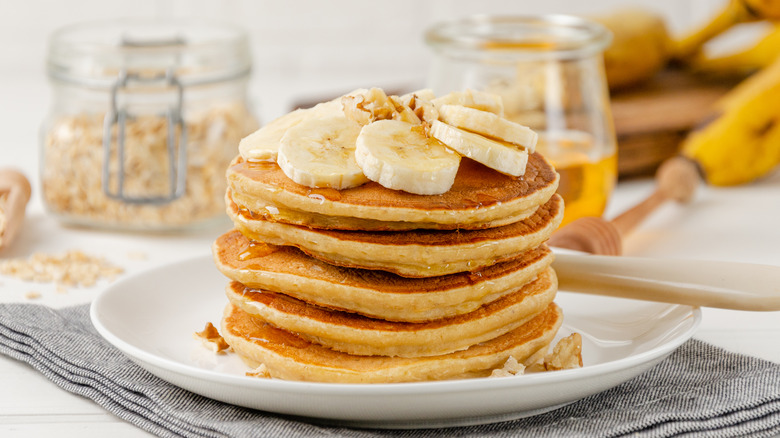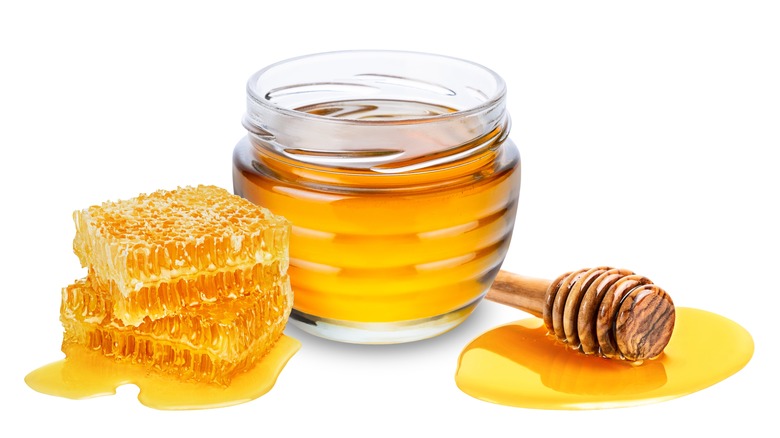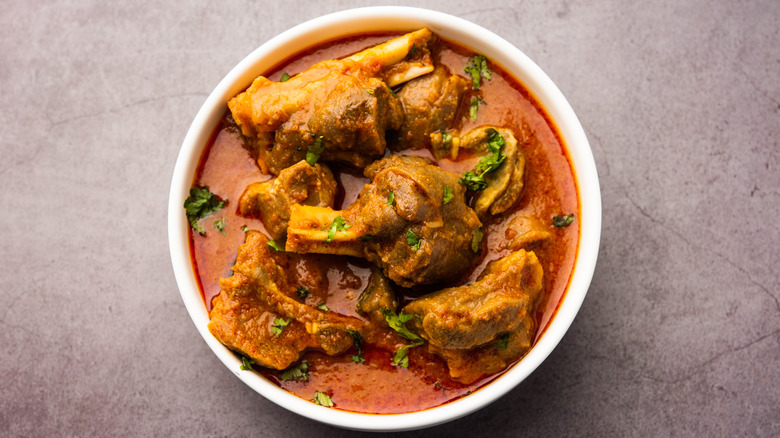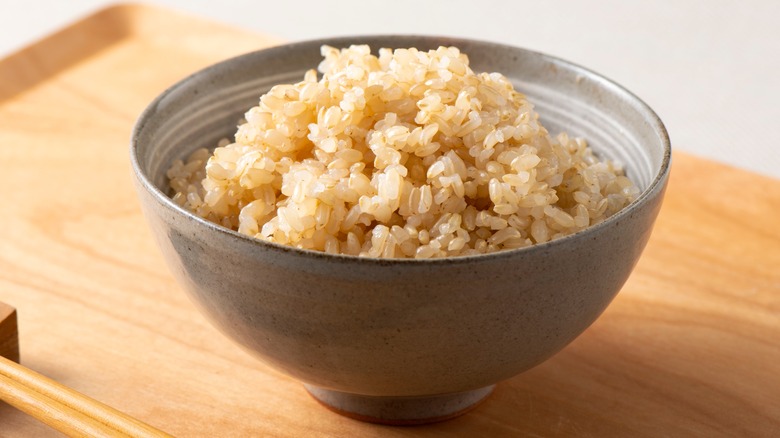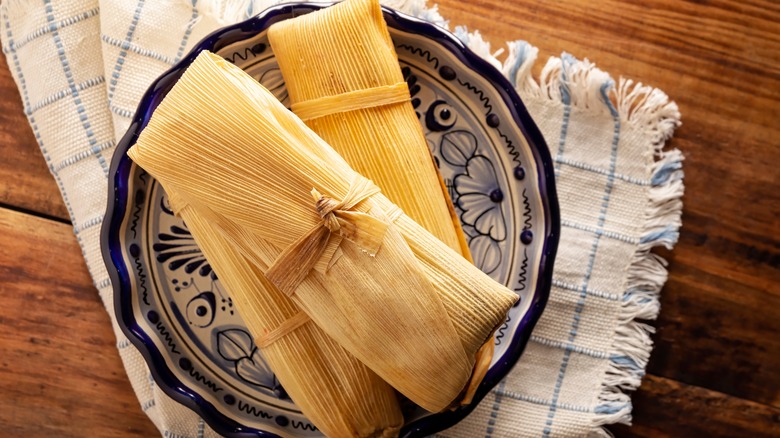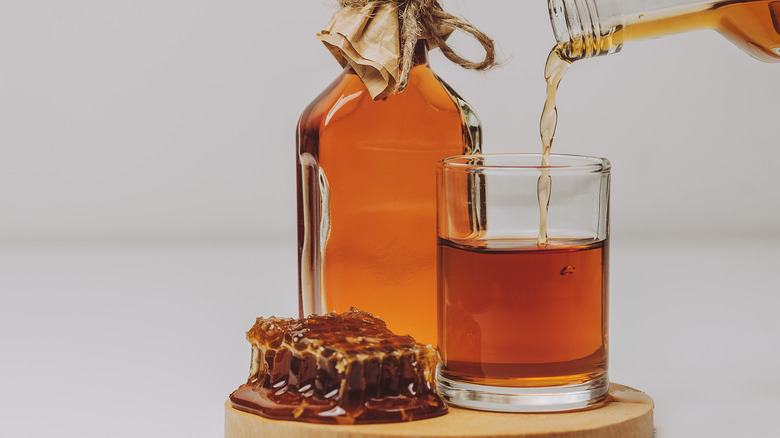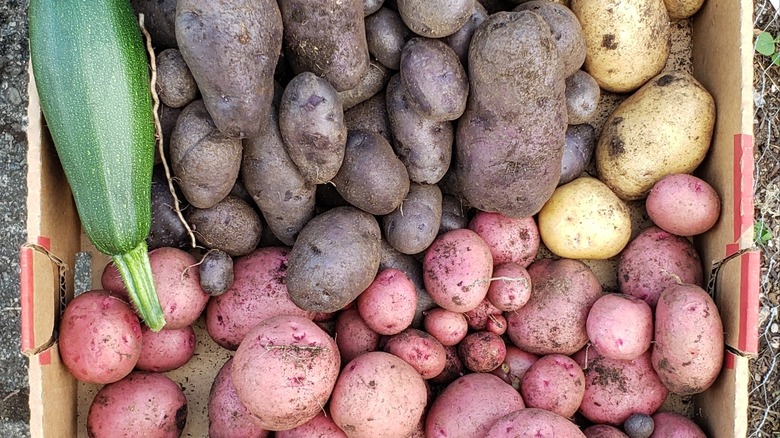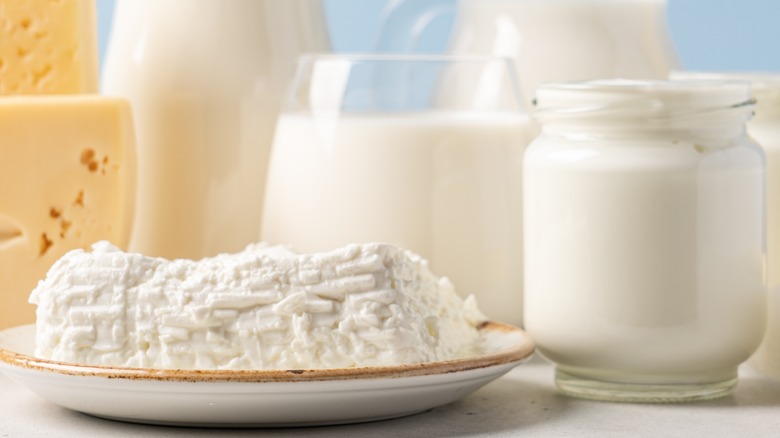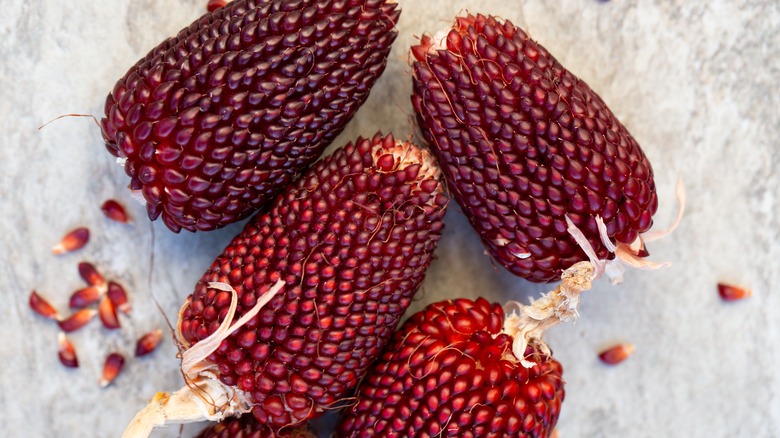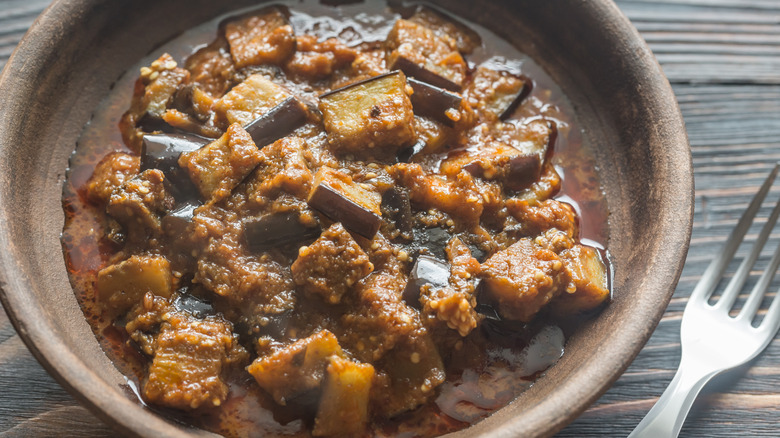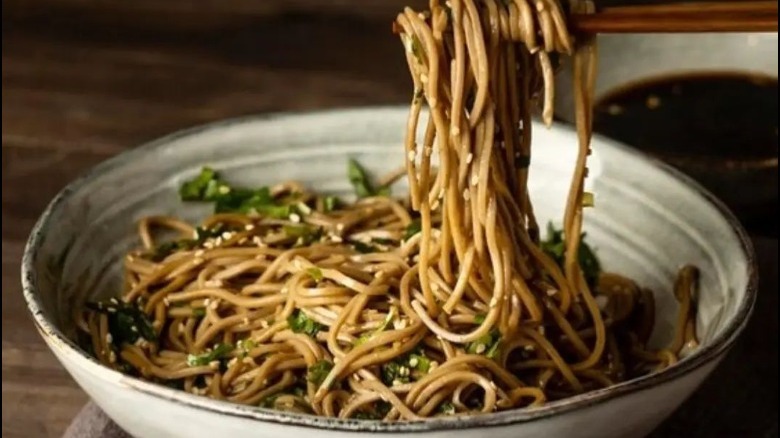Foods That Are Much Older Than We Realized
While we don't often stop to think about it, some of the foods we eat every day have been around for thousands of years. We were even eating many of them before we moved from a nomadic caveman lifestyle to one where we started domesticating plants and animals to make procuring food that much easier. The truth is that it's difficult to know exactly how long we have been eating some foods because we can only go by the clues archeologists have pieced together along the way. Sometimes, they find evidence that only hints at the truth, while other times they find completely intact pieces of food that leave no doubt that people of a certain time were eating something specific.
You may be surprised to learn just how long we've been eating some of your favorite foods. But which came first? Pancakes or honey? Alcoholic beverages or bread? We may not ever know exactly how old our favorite foods really are, but most of them go back much further than we ever realized.
Pancakes: 70,000 years old
Scientists have learned a lot about what cavemen ate during the Paleolithic period from studying the residue left behind on their teeth. Hominins, which essentially encompasses all of our upright-walking ancestors, weren't out planting fields of grain just yet, but they knew where to gather grains from their environment. Raw and cooked grains date back 40,000 years ago. However, innovative humans were making the first pancakes even earlier. In 2022, scientists found a burnt attempt at a seed pancake from 70,000 years ago at the Shanidar Cave in Iraq. It appeared that the seeds had been mashed into a pancake shape before being cooked. Not only is it the first evidence of a pancake but also the oldest cooked food we've ever found.
Apparently, we humans worked on the pancake concept until we got it right (although most of us still aren't beyond burning one). On Otzi the Iceman's final day before his death in the Italian Alps 5,300 years ago, we think he ate a pancake. The remains in the stomach of this man who lived at the end of the Stone Age included ground einkorn wheat and small bits of charcoal, which tell us his final meal was likely a pancake cooked over hot coals. It's possible he topped it with meat or chewed on some smoked meat along with it since there was also red deer and ibex in his belly.
Honey: 40,000 years old
Oddly enough, it was at least 30,000 years after humans were eating pancakes that we know for sure that they were collecting honey they could put on said pancakes. Honeybees evolved sometime between 80 million and 150 million years ago. Unfortunately, early humans could only steal honey from beehives at the peril of being stung. Luckily, something exciting happened between 30,000 and 40,000 years ago that improved the honey game: Cavemen began using fire as a significant part of their technological toolkit.
We're not sure how soon humans were using smoke to calm the bees so they could steal their honey in mass quantities. The first images in stone art that show the process of using ladders and smoke to acquire honey date to 25,000 years ago. However, the first proof we have of Paleolithic humans having developed ways to collect honey dates back to 40,000 years ago. With fire becoming more of an everyday tool, it's likely that they were using smoke to safely raid beehives for a consistent supply of honey earlier than the first time it appears in art. Whenever it happened, having honey in their regular diet provided more daily calories that were easy to attain and possibly helped homo sapiens develop larger brains than contemporary rivals like Neanderthals.
Stew and soup: 25,000 years ago
Determining when people first heated ingredients together with liquids for a stew is an impossible task based entirely on speculation. It likely corresponded with cooking, which is believed to have first happened some 300,000 years ago. To vary their diets and avoid succumbing to protein poisoning, Neanderthals had to cook meat to get to the fat. And if they did it in a waterproof and heatproof container, the juices would have created a broth for the first meat stew. Archeologists found cooked grain residue in Iranian Neanderthal teeth from 46,000 years ago. However, there's no specific proof of stew.
Pots for holding food have been around for at least 20,000 years. However, pots aren't the only way to make a stew. Any waterproof container that could go over a fire would make cooking ingredients together with liquids possible. A skin or animal stomach would have worked. Plus, it's also possible to use a hot rock to heat liquid in a skin or a hole in the ground. Archeologists have found proof of steam-cracked rocks as far back as 25,000 years ago, which would indicate that cavemen likely heated rocks to help boil water before they had pottery. It's the closest hint we have about when ancient hominids were first boiling things to eat. And they certainly wouldn't have wanted to miss the nutrition and feeling of fullness they would get from drinking the liquid soup, too.
Bread: 14,000 years old
Humans were using raw and cooked grains in their diets as early as 40,000 years ago and attempted making pancakes made from seeds 30,000 years earlier than that. However, bread was truly an innovation that didn't happen until humans moved into the Mesolithic period. We had transitioned from what we think of as cavemen into more agricultural communities with permanent places to live. For a long time, we thought breadmaking corresponded with our cultivation of cereal grains, but a discovery of pieces of bread made from einkorn wheat and club-rush tubers in the Black Desert in Jordan showed us that humans were making bread as early as 14,000 years ago. Thus, we were making bread at least 4,000 years before we were cultivating grains. We didn't use leavening yet, so it was a flatbread, but it was bread nonetheless.
We had to work harder for our bread back then, collecting the grains wherever we could find them. There's a chance that the desire to make the bread-making process easier is actually what caused our ancestors to try their hand at growing crops with grains that they wanted to use to make bread. After all, the process was already difficult enough with separating the grains from the chaff, pounding it into flour, mixing it with water, and baking it in hot ashes or on a heated stone.
Rice: 9,000 to 14,000 years old
When humans first started to cultivate rice rather than gather it in the wild is a subject of much debate. It's still not certain how much time passed between when humans first started eating rice and when we figured out how to cultivate it. Thus, we've provided a wide range here, which indicates humans started eating cultivated rice sometime between the Paleolithic and Neolithic periods.
Phytoliths are microscopic silicon skeletons from decayed plants, which is usually all that remains behind. Archeologists discovered rice phytoliths from 13,000 to 14,000 years ago in Xianrendong and Diotonhuan, China. Scientists also found large amounts of phytoliths in nearby Shangshan and Bashidang dating from 10,000 years ago. However, they can't agree whether that rice was still wild, cultivated (human-planted), or even domesticated (grown deliberately with desired traits in mind).
Archeologists found an alcoholic rice beverage in pottery in China dating from 9,000 years ago, which could have corresponded with some of the earliest cultivated rice. In Uttar Pradesh, India, we've found rice together with pottery, dating from 8,500 years ago. Some archeologists think we were cultivating rice in some areas of China 7,400 to 8,000 years ago because we've found what appear to be shovels made from bones in areas with rice. In the Lower Yangzte area, archeologists have found increasingly larger rice phytoliths from the period between 5,500 and 8,000 years ago, which suggests that humans were not only cultivating rice but were also domesticating it to produce larger grains.
Tamales: 7,000 to 10,000 years old
When you're a Mesolithic human living in a permanent dwelling and have agriculture along with handy tools like spears and arrows, you need a convenient way to carry your lunch to the fields and forests. So, some smart person in the times before Ziploc bags and Tupperware decided that corn husks would make great food wrappers for corn-based tamales. Without pots for steaming, Aztecs buried the earliest tamales in hot ashes to cook.
The history of tamales is unclear. Some scholars think they could be as old as 7,000 to 10,000 years old. However, the first fossilized evidence of tamales comes from Teotihuacán, Mexico, in a civilization that existed 2,270 to 2,770 years ago. Although, tools for removing the hard outer shell of corn to make cornmeal date back only to around 3,500 to 3,200 years ago.
Like the Mexican soup pozole, the legends around the earliest tamales involve cannibalism. One myth tells how a deity named Tzitzimitl sacrificed her grandson Chicomexóchitl (an Aztec child god) to use as meat for the first 20 tamales ever made. The first ever corn stalk sprouted from Chicomexóchitl's grave. The legend goes on to explain that all the world's corn originated from the seven ears of corn that grew from that original stalk. Tamales were often at the center of religious celebrations as offerings to gods throughout Mexico.
Alcoholic beverages: 9,000 years old
You would think that alcoholic beverages have been around for a long time. After all, even bees get drunk off of rotting fruit that has fallen off trees and begun to ferment. It couldn't have been that difficult for early humans to discover they could become tipsy from eating fermented fruit. However, the oldest evidence we have of humans actually keeping fermented beverages in pots goes back 9,000 years ago. Archeologists found the sample in an ancient village in the Yellow River Valley in China. The chemicals scientists were able to detect inside the pottery suggested that the alcoholic beverage was made from fruit, honey, and rice. So, it was a fruity rice mead of sorts. It only takes a couple of days for yeast to begin multiplying in a warm climate when you mix honey and fruit skins, so it's a good guess that the drink was a fermented one, even though the only clues we had were the chemicals that had absorbed into the pottery jars themselves.
The tartaric acid found in the beverage most likely came from the fruit of the hawthorn tree since Europeans most likely didn't bring grapes to China until about 4,000 years ago. Other sources for the tartaric acid could have been the Asiatic cornelian cherry. However, there's also the possibility that the tartaric acid came from a non-fruit source, such as geranium-family plant leaves or Saccharified rice.
Potatoes: 8,000 years old
All the world's potatoes originated in the Andes mountains of Peru. While most of us have only encountered a handful of potato types, nearly 5,000 kinds of potatoes exist. Peruvians initially didn't eat wild potatoes because they were toxic. However, they eventually noticed that animals related to today's llamas could eat potatoes without ill effects after eating clay. Toxic compounds like solanine and tomatine that the plants used as a defense mechanism would stick to the clay and pass through the animal without making it sick. So, early humans began experimenting with dunking their potatoes in clay slurries before they finally domesticated less-toxic potatoes about 8,000 years ago. Even today, you can find powdered clay sold with potatoes in Peru and Bolivia.
Not only were potatoes nutritious and filling, but they could also be preserved for leaner times. Peruvians learned that freezing and thawing potatoes over multiple cold nights and warmer mornings produced a gnocchi-like product called chuño, which lasts for years without refrigeration.
Upon discovering people eating potatoes in Peru in the mid-1500s, Spanish conquistadors brought the potato and Peruvian guano fertilizer back to Europe. The earliest ones didn't really fare well with a new climate since potatoes didn't start maturing until too close to the first frosts. They were, however, successful in Ireland because the autumns were milder. Eventually, varieties that were better suited to non-Peruvian climates spread eastward.
Soft cheese and yogurt: 7,200 years old
When we switched from our hunter/gatherer lifestyle to a more agricultural lifestyle during the Neolithic period, we started domesticating animals. With plenty of milk available, we started experimenting with turning the milk into other products like soft cheese and yogurt. So far, the earliest evidence of humans making cheese has been from the Dalmatian Coast of Croatia from about 7,200 years ago, where we found milk fat left behind in pottery. Archeologists found evidence of milk in other pottery from the area dating from 500 years earlier, so 500 years was plenty of time to start discovering how to make other dairy products.
Being able to turn milk into products like cheese and yogurt was significant. About 60% of modern-day humans can't digest lactose very well after childhood, and even fewer could before early European genetic adaptations to dairy. Being able to provide milk to children helped raise infant mortality rates if mothers had difficulty providing breast milk. However, since fermented dairy products like yogurt and cheese contain less lactose, people of all ages were suddenly able to use milk as a source of nutrition, even beyond infancy and childhood. Plus, cheese and yogurt last longer than ordinary milk.
Popcorn: 6,700 years old
Snacks are a good thing, even in a Neolithic village. Humans first domesticated corn in Mexico 10,000 years ago, which is thousands of years before we think they managed to turn it into popcorn. When archeologists began to examine ridiculously old corn cobs on the northern coast of Peru, they discovered they were 6,700 years old. Even more interesting is that the corn cobs were clearly from popcorn. The cobs had been picked clean of the tasty snack, but it was clear that the cob had contained popcorn. The popcorn wasn't the fluffy white version we have today. Instead, it was more in the neighborhood of parched corn like CornNuts.
It's unsure exactly how Peruvians were cooking their popcorn. If they lay the corn cob over a bed of coals, they would need to have wrapped it in something. Another more contained option would have been to place the corn cob inside a hot oven.
Curry: 4,000 years old
If you love curry, you're going to be thrilled to discover that we know exactly what was in the world's oldest curry (at least the oldest we've found so far). A small piece of pottery from the Farmana archeological site in Haryana, India, offered up its 4,000-year-old secrets of the ingredients of curry it once contained: eggplant, turmeric, and ginger.
Keep in mind that, 4,000 years ago, India hadn't yet experienced the wonders of some of the ingredients we see in Indian curries today that came from other areas of the world. Tomatoes didn't reach India until the 1500s, potatoes didn't arrive until the 1700s, and black pepper surprisingly provided most of the heat in Indian food until the Portuguese introduced chili peppers sometime between the late 1400s and the 1700s. While the ginger would have given this Bronze Age curry a small amount of heat, it wouldn't have been nearly as hot as Indian curries can be today.
Noodles: 4,000 years old
When it comes to foods people ate thousands of years ago, we're usually left to piece together clues based on tiny pieces of residue left behind. However, that wasn't the case when it came to the oldest noodles we've discovered so far. A person living in northern China 4,000 years ago turned over their bowl of millet noodles and left them that way until a lucky archeologist found them. The noodles in that overturned bowl were amazingly still recognizable as noodles. It's certainly possible that people were making noodles earlier or elsewhere as they experimented with what was possible with all the grains they were domesticating. However, we haven't found them yet.
There's still a debate about how noodles spread and from where. The Chinese like to claim noodles as their own invention, crediting Marco Polo with spreading them westward along the Silk Road. Meanwhile, Italians swear that Polo and generations of his ancestors had been eating noodles long before he ever traveled to China. Some archeologists posit the possibility of another middle country inventing and spreading noodles east to Italy and west to China. For now, it's all guesses.
Cheesecake: 4,000 years old
The earliest known cheesecakes didn't quite look like the ones we eat today, but they were still cakes made from cheese. The first physical evidence we have for cheesecakes comes from a Greek island called Samos, where anthropologists found cheese molds that the ancient Greeks had used 4,000 years earlier to make cheesecake. In Greece, cheesecakes are called plakountas (placenta cakes). These placenta cakes appeared in the first Olympic games in 776 B.C., where they helped give athletes the energy to reach their highest athletic potential.
The first cheesecakes may not have been sweet, but they eventually turned into more of a dessert dish. A Roman politician named Marcus Porcius Cato wrote down a recipe for a cheesecake called libum. He lived from 234 to 149 B.C., so over 2,000 years had passed since the earliest cheesecakes for which we have evidence. The recipe called for mixing two pounds of cheese, a pound of wheat-based bread flour, and an egg before baking it atop leaves. A later recipe from 230 A.D. from the Greek writer Athenaeus called for adding honey. There's no clear indication of what type of cheese early Greeks were using, but in both recipes authors talk about pounding the cheese to get it to the right consistency.
